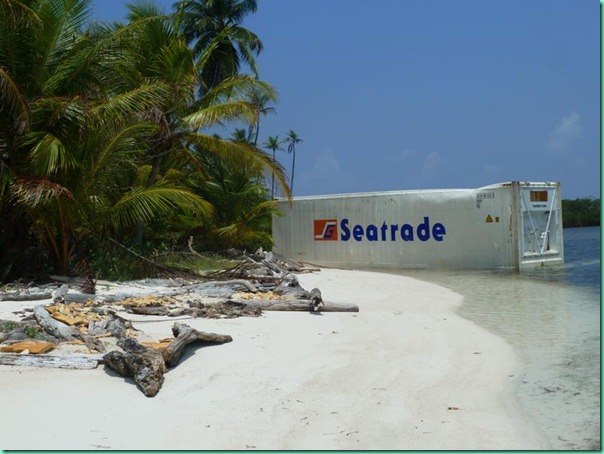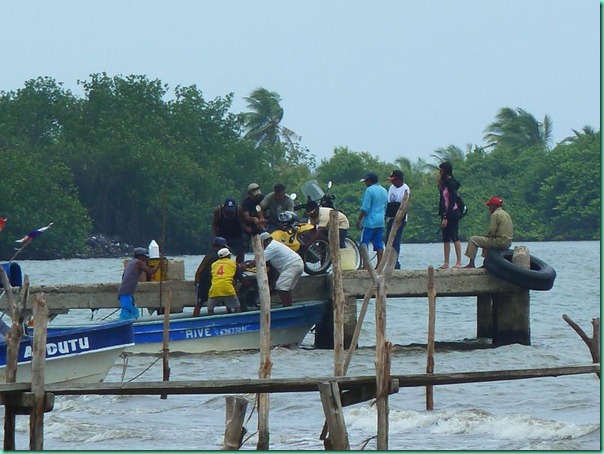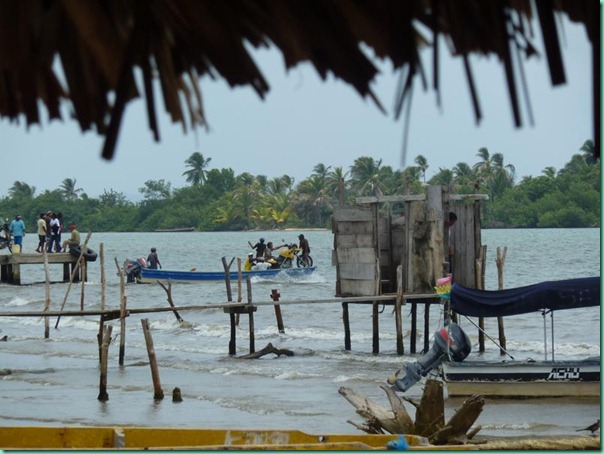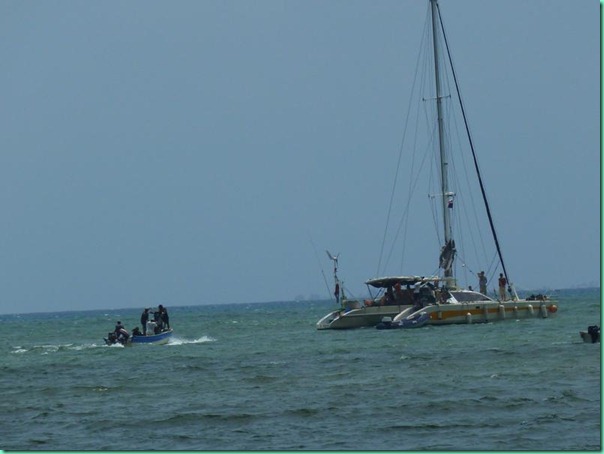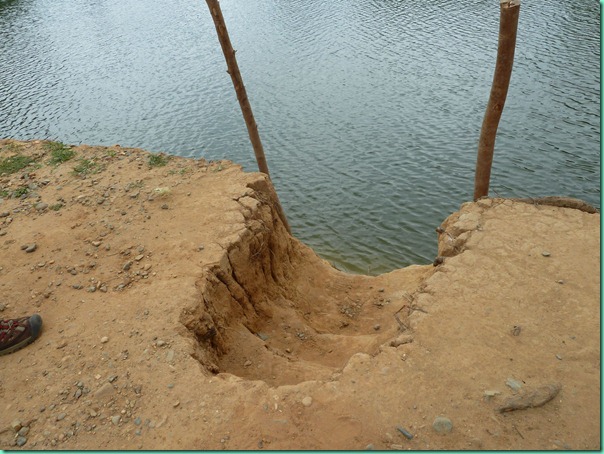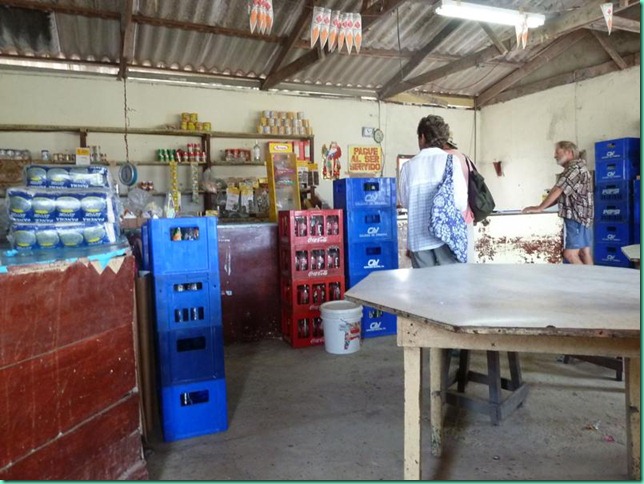
We did a lot of grocery shopping before we left Cartagena. Seemed like every day I was off to some different store or market, wandering dazedly around reading the shelves, wondering what I’d find, and what I’d need. I stuffed the bilges, stuffed the lockers, filled all my canning jars. It was a relief to leave town, and not have to do that any more.
Since then, it’s been a gradual eating down through the layers. After two and a half months, we are beginning to run out of things, despite being able to pick up a few bits and pieces along the way. There are small tiendas in small pueblos, but what they stock is pretty hit and miss, and aimed at people who buy a little every day; a pound of rice, a can of corned beef, some oil or rice, to supplement what comes from a tree or from the sea. I was going to say we too are eating pretty low on the food chain. But the food chain at the tiendas runs along the low lines of powdered milk and Tang, so that’s part of our diet now too. Yum!
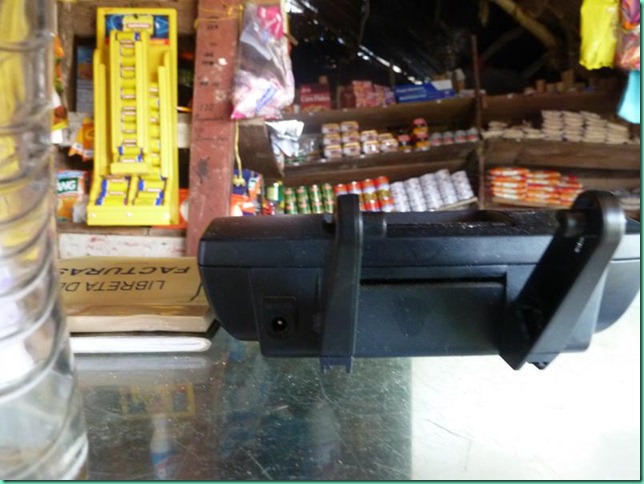
Something in me says that a picture that needs to be explained needs to be deleted, but I like this picture. The big black object in front is a phone/fax, but there is no headset, no service, and probably no future.{why it’s there? Works as a calculator!} Still, we stand over the counter and peer fuzzily at whatever might be back there. I always try to buy something, but sometimes it’s hard.

Here I got potatoes and sewing thread.
The baker’s bread is ready at 3pm, if the water pipe isn’t broken. (The pipe brings water from the river to the town, Nargana, on the island but it seems to be always under repair. And the yachts are sometimes to blame, for not registering what that pair of little buoys, perhaps the only buoys in the archipelago, signifies. ) The baker is a nice man and pretends to understand us, but I think he speaks only Kuna. I’ve needed, and kneaded, a lot of my own bread recently; we either have plenty of bread, or none, on board.

In addition to fuel for the body, there’s fuel for the boat, mainly the outboard. Here, we siphoned from the drum through a rag into a plastic gallon jug, then poured into our jerry can. The man had the same siphon-starter that I use.
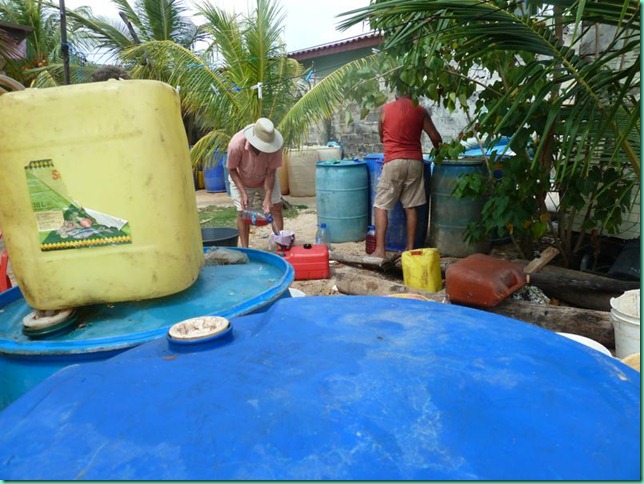
There even is a place in Nargana that sells what they call in the Eastern Caribbean ‘spiritous liquors’, Balboa beer, box wine, Abuela rum (my abuela/granny would have liked it!) !) [OOPs, checking the label I see that’s Abuelo the masculine),and vodka is what I saw. But fellow cruisers reported one day last week that the staff didn’t want to sell any of it; they were having a fiesta and hoped to keep it for themselves. Given the problems of the supply chain – everything comes in by lancha from ?50 miles away, weather-dependent, it must be hard to have people like us around, who drop in from outer space, and buy up everything in bulk, so that we can stay in the cays without coming to town. One day recently, a lancha arrived carrying Digicel sim cards for the phone and Internet modem (hence these photos can be posted, I hope). I hurriedly bought all three of them, (for a friend too) and then tiptoed away in case one of the locals also wanted one.
The reason we haven’t started gnawing the running rigging (maybe I could get my salt there!) is because we are regularly visited by cayugos with something to sell. The season is closed for March, April and May on langousta (lobster), crab, and octopus, and may be closed longer than that for conch, so although we’re offered langousta regularly we decline. But when the man holds up a fish we reel him in. For a Balboa aka a greenback dollar, or two or three, we are getting the nicest freshest fish, cleaned on the spot and often in the pan within the hour. We’ve had some pretty good fish-head soup recently too.

Despite the prohibitions, there is still plenty of fishing for the ‘forbidden’; they said this pile of conch was special for Semana Santa.

The main, probably the only, agricultural product of the offshore islands, is coconut. Every tree, and there may be millions, is owned, and woe unto the cruiser who helps him/herself to a coconut. Why would you, when you can buy them already husked for a quarter?

The trading boats from Colombia are the main buyers of coconuts. They take them back to Colombia for use in lots of food and industrial products. The farther west we travel in the archipelago, the fewer trading boats we see, although they seemed plentiful closer to Colombia. I would not want to travel more than about five miles on one of these boats. For some reason, there seem to be no Panamanian supply boats of this type. But something significant happens where the road meets the water, and I’ll know more about the supply chain when we get that far.

This is the trading vessel Jenny at Corazon de Jesus, which as the TV antennas may indicate, is one of the non-traditional villages. I’ve been trying to find out about the programming, but so far have only been told that it is ‘Christian’.

The veggie boat is the best boat of all. It comes somewhat sporadically to several anchorages in the more populated area around the Lemons and Holandaise cays, usually on Thursday or Friday. They have top quality stuff, at least on day one, and it’s reasonably priced – especially considering the convenience factor. I think I paid $17.50 for this assortment, plus some onions not in the picture.The VHF crackles with the announcements ‘the veggie boat is in the West Lemons, planning to get to the Holandaise today.’ We’re like kiddies tracking Santa’s sleigh.

We (I) have easily spent more buying molas (mola, a word in Kuna for blouse, has come to refer to the intricately cut and sewn layered fabric panels on the blouses) from women like these than we have spent on groceries since we left Cartagena.

Here’s my nicest purchase: the food triangle is not exactly a traditional design, but somehow it spoke to me anyhow.


 My sea-going nephew K learned at an early age that the best small-boat cargo is a waterproof one. Coconuts are waterproof, but they need shade lest they crack open, and they’re heavy. These are destined for ‘food’ in Colombia, and fetch I think about 800 pesos apiece there, not quite doubling in value en route.
My sea-going nephew K learned at an early age that the best small-boat cargo is a waterproof one. Coconuts are waterproof, but they need shade lest they crack open, and they’re heavy. These are destined for ‘food’ in Colombia, and fetch I think about 800 pesos apiece there, not quite doubling in value en route.




